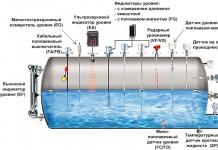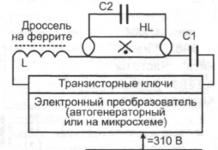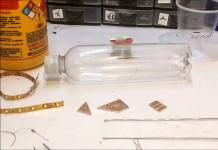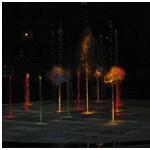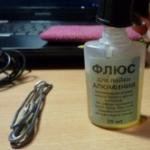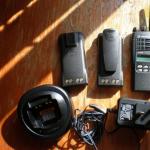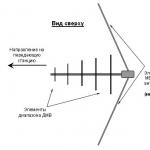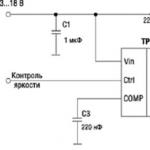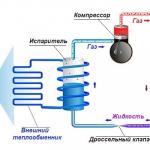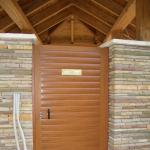A fluorescent lamp (LL) is a glass tube filled with an inert gas (Ar, Ne, Kr) with the addition of a small amount of mercury. At the ends of the tube there are metal electrodes for applying voltage, the electric field of which leads to a breakdown of the gas, the appearance of a glow discharge and the appearance of an electric current in the circuit. The glow of the gas discharge is of a pale blue hue, very weak in the visible light range.
But as a result of an electric discharge, most of the energy goes into the invisible, ultraviolet range, the quanta of which, getting into phosphorus-containing compounds (phosphor coatings), cause a glow in the visible region of the spectrum. By changing the chemical composition of the phosphor, different colors of glow are obtained: various shades of white have been developed for fluorescent lamps (LDS), and lamps of a different color can be chosen for decorative lighting. The invention and mass production of fluorescent lamps is a step forward in comparison with low-efficiency incandescent lamps.
What is ballast for?
The current in the gas discharge grows like an avalanche, which leads to a sharp drop in resistance. In order for the electrodes of the fluorescent lamp not to fail due to overheating, an additional load is switched on in series, limiting the amount of current, the so-called ballast. Sometimes the term choke is used to refer to it.
Two types of ballasts are used: electromagnetic and electronic. The electromagnetic ballast has a classic, transformer configuration: copper wire, metal plates. In electronic ballasts (electronic ballast) electronic components are used: diodes, dinistors, transistors, microcircuits.
For the initial ignition (start) of the discharge in the lamp in electromagnetic devices, an additional starting device is used - a starter. In the electronic version of the ballast, this function is implemented within a single electrical circuit. The device turns out to be light, compact and is united by a single term - an electronic ballast (electronic ballast). The mass use of electronic ballasts for fluorescent lamps is due to the following advantages:
- these devices are compact, have small weight;
- the lamps turn on quickly, but at the same time smoothly;
- absence of flicker and noise from vibration, since the electronic ballast operates at a high frequency (tens of kHz), in contrast to electromagnetic ballasts operating from mains voltage with a frequency of 50 Hz;
- reduction of heat losses;
- electronic ballast for fluorescent lamps has a power factor value of up to 0.95;
- the presence of several, proven types of protection that increase the safety of use and extend the service life.
Schemes of electronic ballasts for fluorescent lamps
Electronic ballast is an electronic board filled with electronic components. Schematic diagram of inclusion (Fig. 1) and one of the variants of the ballast scheme (Fig. 2) are shown in the figures.
 Fluorescent lamp, C1 and C2 - capacitors
Fluorescent lamp, C1 and C2 - capacitors 
Electronic ballasts may have different circuit solutions depending on the components used. The voltage is rectified by diodes VD4-VD7 and then filtered by capacitor C1. After the voltage is applied, the charging of the capacitor C4 begins. At a level of 30 V, the dinistor CD1 breaks through and the transistor T2 opens, then the oscillator on transistors T1, T2 and the transformer TR1 is turned on. The resonant frequency of the series circuit of capacitors C2, C3, inductor L1 and the generator are close in magnitude (45–50 kHz). The resonance mode is necessary for the stable operation of the circuit. When the voltage across capacitor C3 reaches the start value, the lamp lights up. This reduces the control frequency of the generator and voltage, and the inductor limits the current.


Electronic ballast repair
If it is not possible to quickly replace a failed electronic ballast, you can try to repair the ballast yourself. To do this, select the following sequence of actions to troubleshoot:
- First, check the integrity of the fuse. This breakdown is often due to overload (overvoltage) in the 220 volt network;
- then a visual inspection of electronic components is performed: diodes, resistors, transistors, capacitors, transformers, chokes;
- in the event that a characteristic blackening of a part or board is detected, the repair is carried out by replacing it with a serviceable element. How to check a faulty diode or transistor with your own hands, having an ordinary multimeter available, is well known to any user with a technical background;
- it may turn out that the cost of replacement parts will be higher or comparable to the cost of a new electronic ballast. In this case, it is better not to waste time on repairs, but to choose a replacement that is close in parameters.
ECG for compact LDS
Relatively recently, fluorescent energy-saving lamps have become widely used in everyday life, adapted to standard cartridges for simple incandescent lamps - E27, E14, E40. In these devices, the electronic ballasts are inside the cartridge, so repairing these electronic ballasts is theoretically possible, but in practice it is easier to buy a new lamp.
The photo shows an example of such an OSRAM lamp with a power of 21 watts. It should be noted that at present the position of this innovative technology is gradually occupied by similar lamps with LED sources. Semiconductor technology, continuously improving, allows you to quickly reach the price of LDS, the cost of which remains virtually unchanged.

T8 fluorescent lamps
T8 lamps have a glass bulb diameter of 26 mm. The commonly used T10 and T12 lamps have diameters of 31.7 and 38 mm respectively. For lamps, LDS with a power of 18 watts is usually used. T8 lamps do not lose performance during power surges, but if the voltage drops by more than 10%, lamp ignition is not guaranteed. The ambient temperature also affects the reliability of the LDS T8. At sub-zero temperatures, the luminous flux decreases, and failures in the ignition of the lamps may occur. T8 lamps have a life span of 9,000 to 12,000 hours.
How to make a lamp with your own hands?
You can make a simple lamp from two lamps as follows:
- we select 36 W lamps suitable for color temperature (white shade);
- We make the case from a material that will not ignite. You can use the housing from the old lamp. We select electronic ballasts for this power. The marking should have the designation 2 x 36;
- we select 4 cartridges marked G13 for the lamps (the gap between the electrodes is 13 mm), a mounting wire and self-tapping screws;
- cartridges must be fixed on the body;
- the place of installation of electronic ballasts is chosen from the point of view of minimizing heating from operating lamps;
- cartridges are connected to the LDS socles;
- to protect the lamps from mechanical impact, it is desirable to install a transparent or matte protective cap;
- The luminaire is fixed on the ceiling and connected to a 220 V power supply.

I have said more than once that many things that surround us could be implemented much earlier, but for some reason they entered our life quite recently. We all have come across fluorescent lamps - such white tubes with two pins on the ends. Remember how they used to turn on? You press a key, the lamp starts blinking and finally enters its normal mode. It was really annoying, so they didn’t put such things at home. They put them in public places, in production, in offices, in the workshops of factories - they are really economical compared to conventional incandescent lamps. They just blinked at a frequency of 100 times per second, and many people noticed this blinking, which annoyed them even more. Well, for starting each lamp, a ballast was relied on, such a piece of iron with a mass of under a kilogram. If it was not assembled with sufficient quality, then it buzzed rather nastily, also at a frequency of 100 hertz. And if there are dozens of such lamps in the room where you work? Or hundreds? And all these dozens are switched on and off in phase 100 times per second and the throttles are buzzing, though not all of them. Didn't that have any effect?
But, in our time, we can say that the era of buzzing chokes and blinking (both at start-up and during operation) lamps is over. Now they turn on immediately and to the human eye their work looks completely static. The reason is that instead of heavy chokes and periodically sticking starters, electronic ballasts - electronic ballasts - have come into circulation. Small and light. However, with just a glance at their electrical circuit, the question arises: what prevented them from setting up their mass production back in the late 70s and early 80s? After all, the entire element base was already then. Actually, in addition to two high-voltage transistors, the simplest parts are involved there, literally a penny cost, which were in the 40s. Well, okay, the USSR, here the production reacted poorly to technical progress (for example, tube TVs were discontinued only at the end of the 80s), but in the West?
So, in order...
The standard circuit for switching on a fluorescent lamp was, like almost everything in the 20th century, invented by the Americans on the eve of World War II and included, in addition to the lamp, the choke and starter we already mentioned. Yes, a capacitor was also hung in parallel with the network to compensate for the phase shift introduced by the throttle, or, in even simpler terms, to correct the power factor.
Throttles and starters
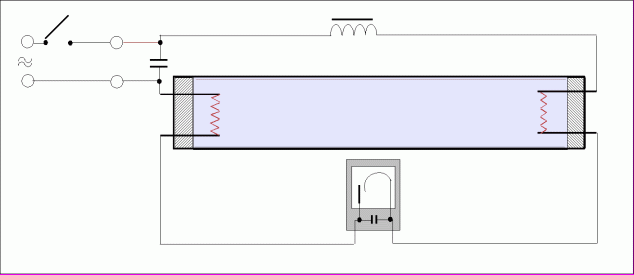 |
The principle of operation of the whole system is quite tricky. At the moment the power button is closed, a weak current begins to flow through the network-button-throttle-first spiral-starter-second spiral-network circuit - approximately 40-50 mA. Weak because at the initial moment the resistance of the gap between the starter contacts is large enough. However, this weak current causes ionization of the gas between the contacts and begins to increase sharply. From this, the starter electrodes heat up, and since one of them is bimetallic, that is, it consists of two metals with different dependences of changes in geometric parameters on temperature (different coefficients of thermal expansion - CTE), when heated, the bimetal plate bends towards the metal with a lower CTE and closes with another electrode. The current in the circuit increases sharply (up to 500-600 mA), but still its growth rate and final value are limited by the inductance of the inductor, the inductance itself is the property to prevent the instantaneous current inductance. Therefore, the throttle in this circuit is officially called the "ballast". This large current heats up the lamp coils, which begin to emit electrons and heat the gas mixture inside the cylinder. The lamp itself is filled with argon and mercury vapor - this is an important condition for the occurrence of a stable discharge. It goes without saying that when the contacts in the starter close, the discharge in it stops. The entire described process actually takes a fraction of a second.
 |
Now the fun begins. The cooled starter contacts open. But the inductor has already stored energy equal to half the product of its inductance and the square of the current. It cannot disappear instantly (see above about inductance), and therefore causes self-induction EMF to appear in the inductor (in other words, a voltage pulse of about 800-1000 volts for a 36-watt lamp 120 cm long). Adding up with the peak mains voltage (310 V), it creates a voltage on the lamp electrodes sufficient for a breakdown - that is, for a discharge to occur. The discharge in the lamp creates an ultraviolet glow of mercury vapor, and this, in turn, affects the phosphor and causes it to glow in the visible spectrum. At the same time, we recall once again that the choke, having inductive resistance, prevents an unlimited increase in current in the lamp, which would lead to its destruction or the operation of a circuit breaker in your home or other place where such lamps are used. Note that the lamp does not always light up the first time, sometimes it takes several attempts to enter a stable glow mode, that is, the processes that we described are repeated 4-5-6 times. Which is actually quite annoying. After the lamp has entered the glow mode, its resistance becomes much less than the resistance of the starter, so it can be pulled out, while the lamp will continue to glow. Well, if you disassemble the starter, you will see that a capacitor is connected in parallel with its terminals. It is needed to attenuate the radio interference created by the contact.
So, if very briefly and without delving into the theory, let's say that a fluorescent lamp is turned on with a large voltage, and is kept in a luminous state by a much lower one (for example, it turns on at 900 volts, it glows at 150). That is, any device for turning on a fluorescent lamp is a device that creates a large turn-on voltage at its ends, and after ignition of the lamp, reduces it to a certain operating value.
This American switching scheme was actually the only one, and only 10 years ago its monopoly began to rapidly collapse - Electronic ballasts (electronic ballasts) entered the market en masse. They made it possible not only to replace the heavy buzzing chokes, to ensure the instantaneous switching on of the lamp, but also to introduce a lot of other useful things, such as:
- soft start of the lamp - preheating of the spirals, which dramatically increases the life of the lamp
- overcoming flicker (the lamp power frequency is much higher than 50 Hz)
— Wide input voltage range 100…250 V;
— reduction of energy consumption (up to 30%) with a constant luminous flux;
- increase in the average lamp life (by 50%);
— protection against power surges;
— to ensure the absence of electromagnetic interference;
- O no switching current surges (important when many lamps are switched on at the same time)
- automatic shutdown of defective lamps (this is important, devices are often afraid of idling)
— Efficiency of high-quality electronic ballast — up to 97%
- dimming lamps
But! All these sweets are realized only in expensive electronic ballasts. And in general, not everything is so cloudless. More precisely, maybe everything would be cloudless if the EPR schemes were made truly reliable. After all, it seems obvious that an electronic ballast (electronic ballast) should in any case be no less reliable than a choke, especially if it costs 2-3 times more. In the "former" circuit consisting of a choke, a starter and the lamp itself, it was the choke (ballast) that was the most reliable and, in general, with a quality assembly, it could work almost forever. Soviet chokes from the 60s still work, they are large and wound with rather thick wire. Imported chokes of similar parameters, even from such well-known companies as Philips, do not work so reliably. Why? The very thin wire with which they are wound is suspicious. Well, the core itself is much smaller in volume than the first Soviet chokes, because these chokes get very hot, which probably also affects reliability.
Yes, so, as it seems to me, electronic ballasts, at least cheap ones - that is, costing up to $ 5-7 apiece (which is higher than that of a throttle), are made deliberately unreliable. No, they can work for years and may even work forever, but here, like in the lottery, the probability of losing is much higher than winning. Expensive electronic ballasts are made conditionally reliable. Why "conditionally" we will tell a little later. Let's start our little review with cheap ones. As for me, they make up 95% of the purchased ballasts. Or maybe almost 100%.
Let's look at a few of these schemes. By the way, all "cheap" schemes are almost identical in design, although there are nuances.
 |
Cheap electronic ballasts (electronic ballasts). 95% sales.
These types of ballasts costing $3-5-7 just turn on the lamp. This is their only function. They don't have any other useful features. I drew a couple of diagrams to explain how this new-fangled miracle works, although, as we said above, the principle of operation is the same as in the “classic” throttle version - we ignite with high voltage, hold it low. It's just implemented differently.
 |
All the electronic ballast circuits (electronic ballasts) that I held in my hands - both cheap and expensive - were a half-bridge - only the control options and “strapping” differed. So, the alternating voltage of 220 volts is rectified by the VD4-VD7 diode bridge and smoothed out by the capacitor C1. In the input filters of cheap electronic ballasts, due to cost and space savings, small capacitors are used, on which the magnitude of voltage ripples with a frequency of 100 Hz depends, despite the fact that the calculation is approximately as follows: 1 watt of a lamp - 1 microfarad of filter capacitance. In this circuit, 5.6 microfarads per 18 watts, that is, clearly less than necessary. Because (although not only because), by the way, the lamp glows visually dimmer than from an expensive ballast for the same power.
Further, through the high-resistance resistor R1 (1.6 MΩ), capacitor C4 begins to charge. When the voltage on it exceeds the response threshold of the bidirectional CD1 dinistor (about 30 volts), it breaks through and a voltage pulse appears at the base of the transistor T2. The opening of the transistor gives rise to the operation of a half-bridge oscillator formed by transistors T1 and T2 and a transformer TR1 with control windings connected in antiphase. Typically, these windings contain 2 turns each, and the output winding contains 8-10 turns of wire.
Diodes VD2-VD3 dampen negative emissions that occur on the windings of the control transformer.
So, the generator starts at a frequency close to the resonant frequency of the series circuit formed by capacitors C2, C3 and inductor C1. This frequency can be equal to 45-50 kHz, in any case, I couldn’t measure it more accurately, I didn’t have a storage oscilloscope at hand. Note that the capacitance of the capacitor C3 connected between the electrodes of the lamp is approximately 8 times less than the capacitance of the capacitor C2, therefore, the voltage surges on it are as many times higher (since the capacitance is 8 times greater - the higher the frequency, the greater the capacitance on a smaller capacity). That is why the voltage of such a capacitor is always chosen to be at least 1000 volts. At the same time, a current flows through the same circuit, heating the electrodes. When the voltage across the capacitor C3 reaches a certain value, a breakdown occurs and the lamp lights up. After ignition, its resistance becomes much less than the resistance of the capacitor C3 and it has no effect on further operation. The oscillator frequency is also reduced. Inductor L1, as in the case of the "classic" inductor, now performs the function of limiting the current, but since the lamp operates at a high frequency (25-30 kHz), its dimensions are many times smaller.
Ballast appearance. It can be seen that some elements are not soldered to the board. For example, where I soldered a current-limiting resistor after repair, there is a wire jumper.
Another product. Unknown manufacturer. Here, 2 diodes were not donated to make an "artificial zero".
 |

|
"Sevastopol scheme"
There is an opinion that no one will do it cheaper than the Chinese. I was sure of it too. I am sure until the electronic ballasts of a certain “Sevastopol plant” fell into my hands - in any case, the person who sold them said just that. They were designed for a 58 W lamp, that is, 150 cm in length. No, I will not say that they did not work or worked worse than the Chinese ones. They worked. Their lamps glowed. But…
Even the cheapest Chinese ballasts (electronic ballasts) are a plastic case, a board with holes, a mask on the board from the printed circuit board and a designation - where is which part from the installation side. The "Sevastopol variant" was devoid of all these redundancies. There, the board was at the same time the cover of the case, there were no holes in the board (for this reason), there were no masks, no markings, the details were placed on the side of the printed conductors and everything that could be made of SMD elements, which I never I have not seen even in the cheapest Chinese devices. Well, the scheme itself! I have looked at a great many of them, but have never seen anything like it. No, everything seems to be like the Chinese: an ordinary half-bridge. That's just the purpose of the elements D2-D7 and the strange connection of the base winding of the lower transistor is absolutely incomprehensible to me. And further! The creators of this miracle device combined a half-bridge generator transformer with a choke! They just wound the windings on a W-shaped core. No one thought of this before, not even the Chinese. In general, this scheme was designed either by geniuses or alternatively gifted people. On the other hand, if they are so brilliant, why not donate a couple of cents to introduce a current-limiting resistor to prevent current inrush through the filter capacitor? Yes, and for a varistor for smooth heating of the electrodes (also cents) - they could go broke.
IN THE USSR
The above "American circuit" (choke + starter + fluorescent lamp) is powered by an alternating current with a frequency of 50 hertz. What if the current is constant? Well, for example, the lamp must be powered by batteries. Here you can’t get by with an electromechanical option. You need to "sculpt the scheme." Electronic. And such schemes were, for example, in trains. We all traveled in Soviet cars of varying degrees of comfort and saw these fluorescent tubes there. But they were powered by a direct current of 80 volts, such a voltage is produced by a car battery. For power supply, the “same” circuit was developed - a half-bridge generator with a series resonant circuit, and to prevent current surges through the lamp coils, a direct heating thermistor TRP-27 with a positive temperature coefficient of resistance was introduced. The circuit, it must be said, was exceptionally reliable, and in order to convert it into a ballast for an AC network and use it in everyday life, it was necessary, in fact, to add a diode bridge, a smoothing capacitor and slightly recalculate the parameters of some parts and the transformer. The only "but". Such a thing would be quite expensive. I think its cost would be no less than 60-70 Soviet rubles, with a throttle cost of 3 rubles. Basically, because of the high cost in the USSR of powerful high-voltage transistors. And this circuit also emitted a rather unpleasant high-frequency squeak, not always, but sometimes it could be heard, perhaps the parameters of the elements changed over time (capacitors dried up) and the frequency of the generator decreased.
Power supply scheme for fluorescent lamps in trains in good resolution
 |
Expensive electronic ballasts (electronic ballasts)
An example of a simple "expensive" ballast is a TOUVE product. He worked in the aquarium lighting system, in other words, two 36-watt green llamas were fed from him. The owner of the ballast told me that this thing is something special, specially designed for lighting aquariums and terrariums. "Ecological". I didn’t understand what environmental friendliness was there, it’s another matter that this “environmental ballast” did not work. The opening and analysis of the circuit showed that, compared to cheap ones, it is significantly more complicated, although the principle - half-bridge + launch through the same DB3 dinistor + series resonant circuit - is preserved in full. Since there are two lamps, we see two resonant circuits T4C22C2 and T3C23C5. The cold coils of the lamps are protected from inrush current by thermistors PTS1, PTS2.
Rule! If you buy an economical lamp or an electronic ballast, check how this lamp turns on. If instantly - the ballast is cheap, no matter what they tell you about it. In more or less normal, the lamp should turn on after pressing the button after about 0.5 seconds.
Further. The RV input varistor protects the power filter capacitors from inrush current. The circuit is equipped with a power filter (circled in red) - it prevents high-frequency interference from entering the network. The Power Factor Correction is outlined in green, but in this circuit it is assembled on passive elements, which distinguishes it from the most expensive and fancy ones, where a special microcircuit controls the correction. We will talk about this important problem (power factor correction) in one of the following articles. Well, a protection unit in abnormal modes has also been added - in this case, generation is stopped by closing the base Q1 with the SCR thyristor to the ground.
For example, deactivation of the electrodes or a violation of the tightness of the tube leads to the appearance of an “open circuit” (the lamp does not light up), which is accompanied by a significant increase in the voltage on the starting capacitor and an increase in the ballast current at the resonance frequency, limited only by the quality factor of the circuit. Prolonged operation in this mode leads to damage to the ballast due to overheating of the transistors. In this case, the protection should work - the SCR thyristor closes the Q1 base to the ground, stopping generation.
 |
It can be seen that this device is much larger in size than cheap ballasts, but after repair (one of the transistors flew out) and restoration, it turned out that these same transistors heat up, as it seemed to me, more than necessary, up to about 70 degrees. Why not put small radiators? I do not claim that the transistor flew out due to overheating, but it is possible that operation at elevated temperatures (in a closed case) served as a provoking factor. In general, I put small radiators, since there is a place.
Fluorescent lamps cannot work directly from a 220V network. To ignite them, you need to create a high voltage pulse, and before that, warm up their spirals. To do this, starters are used. They are of two types - electromagnetic and electronic. In this article, we will look at electronic ballasts for fluorescent lamps, what they are and how they work.
What is a fluorescent lamp made of and what is a ballast for?
A fluorescent lamp is a gas-discharge light source. It consists of a tubular flask filled with mercury vapor. Spirals are located along the edges of the flask. Accordingly, a pair of contacts is located on each edge of the bulb - these are the conclusions of the spiral.

The operation of such a lamp is based on the luminescence of gases when an electric current flows through it. But the current just like that between two metal spirals (electrodes) will not just flow. To do this, a discharge must occur between them, such a discharge is called glowing. To do this, the spirals are first heated by passing a current through them, and after that a high voltage pulse of 600 or more volts is applied between them. The heated coils begin to emit electrons and a discharge is formed under the action of high voltage.
If you do not go into details, then the description of the process is sufficient to set the task for the power source of such lamps, it must:
1. Warm up the coils;
2. Form an ignition impulse;
3. Maintain voltage and current at a sufficient level to operate the lamp.
Interesting: Compact fluorescent lamps, more commonly referred to as "energy-saving", have a similar structure and requirements for their operation. The only difference is that their dimensions are significantly reduced due to a special shape, in fact it is the same tubular flask, the shape is not linear, but twisted into a spiral.

A device for powering fluorescent lamps is called a ballast (abbreviated ballast), and in the people simply - a ballast.
There are two types of ballast:
1. Electromagnetic (Empra) - consists of a throttle and a starter. Its advantages are simplicity, and there are a lot of disadvantages: low efficiency, pulsations of the light flux, interference in the mains during its operation, low power factor, buzz, stroboscopic effect. Below you can see its scheme and appearance.



2. Electronic (electronic ballasts) - a modern power source for fluorescent lamps, it is a board on which a high-frequency converter is located. It is deprived of all the disadvantages listed above, due to which the lamps give out a greater luminous flux and service life.

A typical electronic ballast consists of the following units:
1. Diode bridge.
2. A high-frequency generator made on a PWM controller (in expensive models) or on an auto-generator circuit with a half-bridge (most often) converter.
3. Trigger threshold element (usually a DB3 dinistor with a threshold voltage of 30V).
4. Igniting power LC circuit.
A typical diagram is shown below, consider each of its nodes:

The alternating voltage is supplied to the diode bridge, where it is rectified and smoothed by a filter capacitor. In the normal case, a fuse and an electromagnetic interference filter are installed before the bridge. But in most Chinese electronic ballasts there are no filters, and the capacity of the smoothing capacitor is lower than necessary, which causes problems with the ignition and operation of the lamp.

Tip: if you are repairing electronic ballasts, then read the article on our website.
After that, the voltage is supplied to the oscillator. From the name it is clear that an oscillator is a circuit that independently generates oscillations. In this case, it is made on one or two transistors, depending on the power. The transistors are connected to a transformer with three windings. Usually transistors like MJE 13003 or MJE 13001 and the like are used, depending on the power of the lamp.

Although this element is called a transformer, it does not look familiar - it is a ferrite ring on which three windings are wound, several turns each. Two of them are control, each with two turns, and one is working with 9 turns. The control windings create pulses to turn on and off the transistors, connected at one end to their bases.
Since they are wound in antiphase (the beginnings of the windings are marked with dots, pay attention to the diagram), the control pulses are opposite to each other. Therefore, the transistors open in turn, because if they are opened at the same time, then they simply close the output of the diode bridge and one of these will burn out. The working winding is connected at one end to the point between the transistors, and at the other end to the working inductor and capacitor, the lamp is powered through it.

When current flows in one of the windings, an EMF of the corresponding polarity is induced in the other two, which leads to switching transistors. The oscillator is tuned to a frequency above the audio range, that is, above 20 kHz. It is this element that is a DC-to-AC converter.
To start the generator, a dinistor is installed, it turns on the circuit after the voltage on it reaches a certain value. Usually, a DB3 dinistor is installed, which opens in the voltage range of about 30V. The time after which it opens is set by the RC circuit.
Retreat:
More advanced versions of electronic ballasts are not built on a self-oscillating circuit, but on the basis of PWM controllers. They have more stable characteristics. However, for more than five years of doing electronics, I have never come across such an electronic ballast, all of which I worked with were self-oscillating.
The LC circuit has been repeatedly mentioned above. This is a choke installed in series with a spiral, and a capacitor installed in parallel with the lamp. A current flows through this circuit, heating the coils, and then a high voltage pulse is formed on the capacitor, igniting it. The inductor is made on a W-shaped ferrite core.
These elements are selected so that at the operating frequency they enter into resonance. Since the inductor and capacitor are installed in series, voltage resonance is observed at this frequency.
At the resonance of the voltages on the inductance and capacitance, the voltage begins to grow strongly in idealized theoretical examples to an infinitely large value, while the current consumed is extremely small.
As a result, we have a frequency-matched generator and a resonant circuit. Due to the increase in voltage across the capacitor, the lamp ignites.
Below is another version of the circuit, as you can see - everything is basically the same.

Due to the high operating frequency, it is possible to achieve small dimensions of the transformer and inductor.
To consolidate the information passed, consider a real electronic ballast board, the main nodes described above are highlighted in the picture:

And this is a board from an energy-saving lamp:

Conclusion
The electronic ballast significantly improves the ignition process of the lamps and works without pulsations and noise. Its circuit is not very complicated and a low-power power supply can be built on its basis. Therefore, electronic ballasts from burned-out energy savers are an excellent source of free radio components.
Fluorescent lamps with electromagnetic ballasts must not be used in industrial and domestic premises. The fact is that they have strong pulsations, and a stroboscopic effect may appear, that is, if they are installed in a turning workshop, then at a certain speed of rotation of the spindle of a lathe and other equipment, it may seem to you that it is stationary, which can cause injury . This will not happen with electronic ballast.
An electromagnetic or electronic ballast for fluorescent lamps is needed for the normal operation of this light source. The main task of the ballast is to convert direct voltage into alternating voltage. Each of them has its pros and cons.
How does LL work with electromagnetic ballast?
 Scheme of connecting the ballast to the LL
Scheme of connecting the ballast to the LL Pay attention to this wiring diagram. Marking LL1 is a ballast. Inside the fluorescent lamps is a gaseous medium. With increasing current, the voltage between the electrodes in the lamp gradually decreases, and the resistance is negative. The ballast is used just to limit the current, and also creates an increased short-term lamp ignition voltage, since it is not enough in a conventional network. This element is also called a throttle.
In such a device, a starter is used - a small glow discharge lamp (E1). It contains two electrodes. One of them is bimetallic (movable).
In their original position, they are open. By closing contact SA1 and applying voltage to the circuit, the current does not first pass through the light source, but a glow discharge appears in the starter between the two electrodes. The electrodes are heated, and the bimetallic plate bends as a result, closing the contact. The current passing through the ballast increases, heating the electrodes of the fluorescent lamp.
Next, the electrodes in the starter open. There is a process of self-induction. The inductor creates a high voltage pulse, which ignites the LL. The rated current passes through it, but then it drops by half due to a decrease in the voltage across the inductor. The starter electrodes remain in the open position as long as the light is on. And capacitors C2 and C1 increase efficiency and reduce reactive loads.
 Connecting fluorescent lamps
Connecting fluorescent lamps Advantages of classic electromagnetic ballast:
- low cost;
- ease of use.
Cons of EMPR:
- noise of the working throttle;
- flicker LL;
- long ignition of the lamp;
- weight and large dimensions;
- up to 15% of energy losses due to phase advance of the alternating voltage (power factor);
- poor switching in low temperature environment.
On a note! The problem of energy loss can be solved by connecting (in parallel to the network) a capacitor with a capacitance of 3-5 microfarads.
Advice! The ballast must be selected strictly in accordance with the power of the lamp. Otherwise, your lamp may break prematurely.
The most common causes of LL malfunctions with electromagnetic ballast
The following problems are identified:

How LL works with electronic ballast
Due to the mass of shortcomings of the electromagnetic ballast, a new, more durable and technological electronic ballast was created. This is a single electronic power supply. Now it is the most common, as it is devoid of the shortcomings that exist in the EMPRA. In addition, it works without starters.
For example, let's take a circuit of any electronic ballast.
 Scheme of electronic ballast for fluorescent lamps
Scheme of electronic ballast for fluorescent lamps The input voltage is rectified, as usual, by diodes VD4-VD7. Then comes the filter capacitor C1. Its capacity depends on the power of the lamp. Usually guided by the calculation: 1 uF per 1 W of consumer power.
Next, the capacitor C4 is charged and the dinistor CD1 breaks through. The resulting voltage pulse activates the transistor T2, after which a half-bridge self-oscillator is connected to the work from the transformer TR1 and transistors T1 and T2.
The electrodes of the lamp begin to warm up. To this is added an oscillatory circuit, which enters into electrical resonance before discharging from the inductor L1, the generator and capacitors C2 and C3. Its frequency is about 50 kHz. As soon as the capacitor C3 is charged to the trigger voltage, the cathodes are intensely heated, and the LL is ignited smoothly. The inductor immediately limits the current, and the generator frequency drops. The oscillatory circuit goes out of resonance, and the rated operating voltage is established.
Advantages of electronic ballasts:
- low weight and small dimensions due to high frequency;
- high light output due to increased efficiency;
- LL has no blinking;
- protection of the lamp from voltage drops;
- no noise during operation;
- durability due to optimization of the start-up and operation mode;
- It is possible to set instant start or delayed start.
The disadvantage of electronic ballasts is only the high cost.
Note! An electronic cheap ballast for fluorescent lamps works like an EMPRA: a fluorescent lamp is ignited from a high voltage, and the burning is kept low.
The cause of breakdowns of lamps with electronic ballast, as well as their repair
Yes, nothing is permanent. They break too. But the repair of electronic ballast is much more difficult than that of electromagnetic. Here you need skills in soldering and knowledge of radio engineering. And it doesn’t hurt to also know how to check the electronic ballast for operability if there is no known working LL.
Remove the lamp from the fixture. Close the leads of the filaments, for example, with a paper clip. And between them connect an incandescent lamp. See the picture below.

When power is applied, a working ballast will light the bulb.
Advice! After repairing the ballast, before connecting it to the network, it is better to connect one more incandescent lamp (40 W) in series. This is to the fact that if a short circuit is detected, it will light up brightly, and the parts of the device will remain unharmed.
Most often, 5 parts “fly out” in the electronic ballast:
- Fuse (2-5 ohm resistor).
- Diode bridge.
- Transistors. Together with them, 30 ohm resistors can also burn down the circuit. They fail mainly due to power surges.
- A little less often, a breakdown of the capacitor connecting the filaments is detected. Its capacitance is only 4.7 nF. In cheap fixtures, they put such film capacitors with an operating voltage of 250 - 400 V. This is very small, so it is better to replace them with capacitors of the same capacity, only with a voltage of 1.2 kV, or even 2 kV.
- Dinistor. Often referred to as DB3 or CD1. It is impossible to check it without special equipment. Therefore, if all the elements on the board are intact, and the ballast still does not work, try installing another dinistor.
If you do not have knowledge and experience in electronics, it is better to simply replace your ballast with a new one. Now each of them is produced with instructions and a diagram on the case. Having carefully read it, you can easily connect the ballast yourself.
The main factor in the normal operation of fluorescent lamps is the type of electric current. Since these lighting devices operate on direct current, a ballast or ballast must be installed in their circuit. The most popular is electronic ballast, which has a number of advantages over the electromagnetic unit.
Main varieties
Today there are two types of ballast - electromagnetic and electronic. They differ in the principle of operation, so it is worth getting to know each of them.
electromagnetic ballast
This type of implementation involves connecting the inductor to the lamp in series. Also, for the operation of electromagnetic ballast, a starter is required, with the help of which the ignition process of the lamp is regulated. This part is a gas-discharge lamp, inside the bulb of which there are bimetallic electrodes.
The device works as follows:

When the luminescent device goes into normal operation, the voltage on it and the starter is 50% less than the mains, and this is not enough to trigger the second element. As a result, the starter goes into a disabled state and ceases to affect the operation of the lighting device.
The electromagnetic ballast features low cost and simple structure. For a long time, these devices were actively used in the manufacture of lamps, however, they have a number of disadvantages:
- It takes about 3 seconds for the luminescent device to enter the operating mode.
- Lighting devices with electromagnetic ballast flicker during operation, which negatively affects the organs of vision.
- The energy consumption of these devices is much higher compared to electronic ballast.
- Throttle makes noise during operation.
Due to these shortcomings, electromagnetic ballast for lamps is rarely used today.
Electronic implementation
Electronic devices are voltage converters that provide power to fluorescent lamps. Although many variants of electronic ballast have been created, in most cases a single block diagram is used. At the same time, manufacturers can make certain changes to it, for example, add a lighting fixture brightness control scheme.
Switching the fluorescent lamp of the lamp to normal operation using an electronic PRA is most often carried out in one of two ways:
- Until the ignition voltage is applied to the cathodes of the lamp, they are preheated. This allows you to get rid of flicker, as well as increase the efficiency of the lighting device.
- An oscillatory circuit is installed in the design of the lamp, which enters into resonance before a discharge appears in the lamp bulb.
When using the second method, the electronic ballast circuit is implemented so that the light bulb filament is part of the circuit. As soon as a discharge appears in a gas medium, the parameters of the oscillatory circuit change, after which it goes out of resonance. As a result, the voltage drops to the working voltage.
Schematic diagram of a ballast for 36w lamps.

Today, compact luminescent devices with E14 and E27 bases are widely used. In them, the ballast is installed directly into the design of the device. An example of an electronic ballast circuit for 18w fluorescent lamps is shown below.

Troubleshooting and repair
If there are problems with the operation of discharge lamps, often repairs can be carried out independently. The main task in such a situation is identifying the source of the problem- lighting fixture or ballast. To check the electronic circuit, you must first remove the linear light bulb, close the electrodes and connect an ordinary lamp. If she began to glow, then the problem is not in the ballast.
To troubleshoot fluorescent lighting devices, you first need to ring all the elements one by one, starting with the fuse. If this part turned out to be working, it is necessary to proceed to checking the capacitor and diodes. If all elements of the ballast turned out to be serviceable, it is worth checking the throttle. Timely repair of the lighting device will increase its service life..
